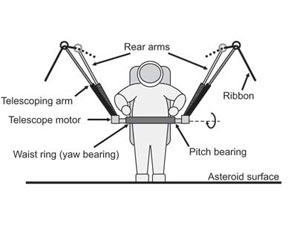|
NEWS NOTES
Space
Lassoing an asteroid
 Ian Garrick-Bethell |
| Astronauts trying to study an asteroid’s nearly zero-gravity environment could have a tough time getting much work done unless they can latch on to it securely. One possible solution? An asteroid tether. |
Interest in asteroids and other near-Earth objects is on the rise — especially because somewhere out there one may be on a collision course with Earth. Even if a manned mission could land safely on such a small object to take a closer look at it, stepping out onto an asteroid isn’t like a walk on the moon, says Ian Garrick-Bethell, a graduate student in MIT’s Department of Earth, Atmospheric and Planetary Sciences. Astronauts trying to work on a slowly rotating small asteroid (up to 20 kilometers in diameter or so) in near-zero-gravity conditions would need some way to anchor themselves down.
So Garrick-Bethell and colleague Christopher Carr, a postdoctoral researcher also at MIT, developed a novel idea: Loop a rope around the asteroid to create a tether the astronauts can latch onto. Although drilling and bolting a machine to the object’s surface to create an anchor might seem more straightforward, little is known about the terrain of asteroids, Garrick-Bethell says. Rather than solid rock, he says, some estimates suggest the objects may be covered in tens of meters of granular, sandy material. “You might find that you fire your device into the ground and there’s no strength — it’s like shooting a barbed hook into a pile of sand.” Furthermore, to drill into the surface of an object, the astronauts would need to exert force — not easy to do when flying around on a jet pack.
A tether would bypass that problem. “I was just thinking of it in the simplest way, as a child would,” Garrick-Bethell says. “Then I put all the numbers into it.” To come up with a workable tether design, Garrick-Bethell and Carr assessed the required forces, rope tensions, materials and configurations, and reported their design online Aug. 24 in Acta Astronautica. Ideally, they wrote, two lassoed ropes would encircle the asteroid. The ropes should be ribbon-shaped, wide enough so that when pulled taut they wouldn’t cut deep grooves into the asteroid’s sides. By strapping an astronaut into a harness that slides along the two ribbons, the astronaut would be both stabilized and able to move freely along the object’s surface.
Although Garrick-Bethell has had some contact with NASA, it hasn’t ordered any tethers quite yet, he says. Overall, however, the interest in near-Earth objects is strong: NASA has recently been investigating sending a manned mission to a near-Earth object, and is considering using a future crew navigation vehicle — part of the Constellation Program, its plan to return astronauts to the moon by 2020 — to make the trip.
In addition to finding out where these near-Earth objects are, how big they are and if any are headed our way (none are currently known to threaten Earth), scientists are also curious to know what the objects are made of and whether they might have usable resources, says Jeffrey Hoffman, a former NASA astronaut and now senior lecturer in MIT’s Department of Aeronautics and Astronautics, who was not involved with the study. And, he says, “we’d like to know what their structure is like, so that if we ever did have to deflect one, we’d know how to do it.”
Another part of the appeal of studying asteroids, Hoffman says, is that it takes much more energy to travel between Earth and Mars or the moon than it does to visit a near-Earth object, because escaping the gravity pull of those larger objects for the return trip requires much more fuel. “With just a little more equipment than we’re already setting out to build, we could actually mount a very interesting mission to a near-Earth object, which would really be true exploration,” he says.
One of the logistical challenges NASA is now weighing is how to land a spacecraft on an asteroid — and how to walk around on it afterwards is yet another question they’ll have to ponder. The astronaut tether idea “is a little bit off the wall, but that’s good,” Hoffman says. “We need clever, original ideas. Trying to solve everything by brute force gets a lot more expensive and difficult.”

 Subscribe
Subscribe


